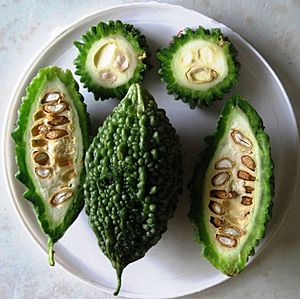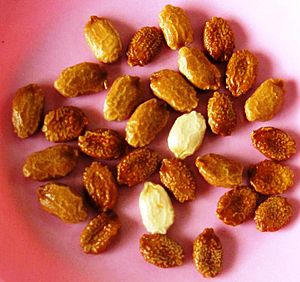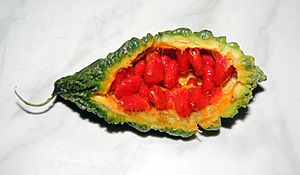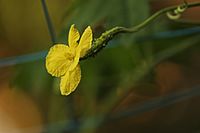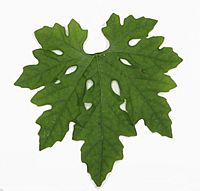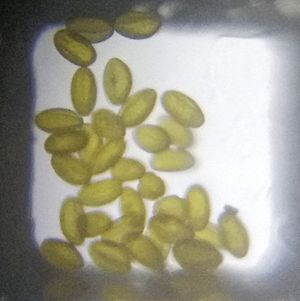Momordica charantia facts for kids
Quick facts for kids Momordica charantia |
|
|---|---|
 |
|
| Botanical illustration of plant parts | |
| Scientific classification | |
| Genus: |
Momordica
|
| Species: |
charantia
|
Momordica charantia is a plant commonly known as bitter melon. People also call it bitter gourd or balsam-pear, among many other names. It's a tropical and subtropical vine from the cucumber family, Cucurbitaceae.
This plant is grown widely in Asia, Africa, and the Caribbean because its fruit can be eaten. There are many different types of bitter melon, and they can look quite different and have varying levels of bitterness.
Bitter melon first came from Africa. It was an important food for hunter-gatherers during dry seasons. Over time, wild or partly farmed versions spread across Asia. It was likely fully grown as a crop in Southeast Asia. Today, it's a popular ingredient in the foods of East Asia, South Asia, and Southeast Asia.
Contents
What is Bitter Melon?
Bitter melon has many names around the world. Here are a few examples from different languages:
| Language | Romanized name | Local script |
|---|---|---|
| Arabic | alhanzil | الحنظل |
| Urdu | karelā | کریلا |
| Hindi | karelā | करेला |
| Japanese | nigauri, gōya | 苦瓜, ゴーヤ |
| Mandarin | kǔguā | 苦瓜 |
| Filipino | ampalaya | ampalaya |
| Thai | mara | มะระ |
Plant Description
This plant is a herbaceous vine that grows up to 5 meters (about 16 feet) long. It has tendrils that help it climb. Its leaves are simple and grow alternately, measuring about 4–12 cm (1.5–4.7 inches) wide. Each leaf has three to seven deep sections.
Each bitter melon plant has separate yellow male and female flowers. In the Northern Hemisphere, the plant usually flowers in June and July. The fruits then grow from September to November.
The fruit itself has a bumpy outside and an oblong shape. Inside, it's hollow with a thin layer of flesh around a central area. This area is filled with large, flat seeds and soft pith.
Bitter melon is usually eaten when it's green or just starting to turn yellow. At this stage, the fruit's flesh is crunchy and watery, a bit like a cucumber or green bell pepper, but it tastes bitter. The skin is soft and can be eaten. The seeds and pith are white in unripe fruits. They are not very bitter and can be taken out before cooking.
As the fruit gets older, some people say the flesh becomes tougher and more bitter. However, for the common Chinese type, the skin doesn't change, and the bitterness might even lessen as it ages. The Chinese variety is best picked when it's light green, maybe with a slight yellow tint.
When the fruit is fully ripe, it turns orange and soft. It then splits open into sections, showing seeds covered in bright red pulp. This red pulp is sweet and can be eaten raw. It's a popular ingredient in some salads in Southeast Asia.
Different Types of Bitter Melon
Bitter melon comes in many different shapes and sizes.
- The type often found in China is about 20–30 cm (8–12 inches) long. It's oblong with rounded ends and is pale green. Its surface is gently bumpy.
- The type more common in India is narrower with pointed ends. Its surface has sharp, triangular "teeth" and ridges. It can be green to white.
There are also many types in between these two. Some have tiny fruits, only 6–10 cm (2.4–3.9 inches) long. These small fruits are popular in Bangladesh, India, Pakistan, and Nepal, where they are sometimes stuffed with other ingredients.
How Bitter Melon is Used in Cooking
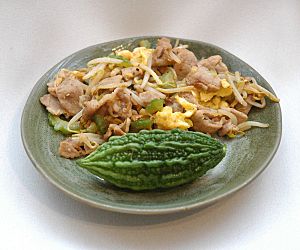
| Nutritional value per 100 g (3.5 oz) | |
|---|---|
| Energy | 79 kJ (19 kcal) |
|
4.32 g
|
|
| Sugars | 1.95 g |
| Dietary fiber | 2 g |
|
0.18 g
|
|
|
Protein
|
0.84 g
|
| Vitamins | Quantity
%DV†
|
| Vitamin A equiv.
beta-Carotene
lutein zeaxanthin
|
1%
6 μg
1%
68 μg1323 μg
|
| Thiamine (B1) |
4%
0.051 mg |
| Riboflavin (B2) |
4%
0.053 mg |
| Niacin (B3) |
2%
0.28 mg |
| Pantothenic acid (B5) |
4%
0.193 mg |
| Vitamin B6 |
3%
0.041 mg |
| Folate (B9) |
13%
51 μg |
| Vitamin C |
40%
33 mg |
| Vitamin E |
1%
0.14 mg |
| Vitamin K |
5%
4.8 μg |
| Minerals | Quantity
%DV†
|
| Calcium |
1%
9 mg |
| Iron |
3%
0.38 mg |
| Magnesium |
5%
16 mg |
| Manganese |
4%
0.086 mg |
| Phosphorus |
5%
36 mg |
| Potassium |
11%
319 mg |
| Sodium |
0%
6 mg |
| Zinc |
8%
0.77 mg |
| Other constituents | Quantity |
| Water | 93.95 g |
|
Link to USDA Database entry
|
|
| †Percentages estimated using US recommendations for adults. | |
People usually cook bitter melon when it's green or slightly yellow. The young shoots and leaves can also be eaten as greens. Since the raw fruit is very bitter, you can soak it in cold water and drain it to reduce the strong taste.
In Chinese cooking, bitter melon (苦瓜) is liked for its bitter flavor. It's often used in stir-fries (sometimes with pork), soups, dim sum, and herbal teas. It has even been used in some beers in China and Okinawa to make them bitter, instead of hops.
Bitter gourd is a common food all over India. In North Indian cuisine, it's often served with yogurt to balance the bitterness. It's also used in curry dishes or stuffed with spices and cooked in oil.
In South Indian cuisine, it's used in many dishes. For example, thoran (mixed with grated coconut) or theeyal (cooked with roasted coconut). Some dishes, like pachadi, are even thought to be good for people with diabetes.
In northern India and Nepal, bitter melon is made into a fresh pickle. It's cut into pieces, cooked with oil and water, then crushed with garlic, salt, and pepper. It's also eaten sautéed until golden, stuffed, or as a curry with or without potatoes.
In Burmese cuisine, bitter melon is stir-fried with garlic, tomatoes, spices, and dried shrimp. It's served with other dishes and can be found at street food stalls.
In Sri Lanka, bitter melon is called karavila. It's used in many different curry dishes served with rice. Sometimes, grated coconut is added. People also drink bitter melon juice there.
In Pakistan and Bangladesh, bitter melon is often cooked with onions, chili powder, turmeric, salt, coriander, and cumin seeds. Another dish in Pakistan involves boiling whole bitter melons, stuffing them with cooked minced beef, and serving them with bread or khichri (a mix of lentils and rice).
In Okinawan and Japanese cooking, bitter melon (called gōyā or nigauri) is a very important ingredient. It's especially popular in Okinawan cuisine.
In Indonesian cuisine, bitter melon (called pare or paria) is used in dishes like gado-gado. It's also stir-fried, cooked in coconut milk, or steamed. In some parts of Eastern Indonesia, it's cooked with pork and chili.
In Vietnamese cuisine, raw bitter melon slices are eaten with dried meat floss. Bitter melon soup with shrimp is also common. Stuffed bitter melons with ground pork are a popular summer soup. This dish is often made for the Tết holiday, as its "bitter" name reminds people of hard times in the past.
In Thai cuisine, the Chinese type of green bitter melon, mara, is stuffed with minced pork and garlic and cooked in a clear broth. It's also stir-fried with garlic and fish sauce. The smallest type of bitter melon, mara khii nok, is usually wild and thought to be the most nutritious.
In the Philippines, bitter melon (called ampalaya or parya) can be stir-fried with ground beef and oyster sauce, or with eggs and diced tomato. A dish called pinakbet uses bitter melons along with other vegetables like eggplant, okra, and string beans, all cooked with a special sauce.
In Trinidad and Tobago, bitter melons (called caraille) are usually stir-fried with onion, garlic, and scotch bonnet pepper until they are almost crispy.
Traditional Uses
For a long time, bitter melon has been used in different traditional medicine systems in Asia and Africa. In Turkey, it has been a folk remedy for stomach problems. In traditional Indian medicine, different parts of the plant are used. People have claimed it helps with diabetes, and also as a laxative or for treating coughs, skin diseases, and wounds.
Scientific Studies
Scientists are studying Momordica charantia to see if it can help with things like cancer prevention, diabetes, fever, and infections. While some early lab tests show promise, more studies are needed to confirm these benefits in humans.
For example, some animal studies and small human studies have shown that strong bitter melon extracts might help lower blood glucose (sugar) levels. A review in 2014 also suggested that eating raw bitter melon or drinking its juice could help lower blood sugar. However, other studies found that bitter melon in capsule or tablet form did not significantly lower blood sugar levels.
So, while bitter melon might be helpful for diabetes, more research is needed to understand how it works best. The Memorial Sloan Kettering Cancer Center states that bitter melon should not be used as a replacement for insulin or other diabetes medications.
In the Caribbean, a tea made from cerasee leaves (a type of bitter melon) is a popular home remedy for stomach aches. The plant grows wild there, and people often make tea with fresh leaves. You can also buy dried leaves in tea bags.
Possible Side Effects
Some people have reported mild side effects from bitter melon. These can include diarrhea, abdominal pain, fever, low blood sugar (hypoglycemia), and chest pain. These symptoms are usually not serious and go away with rest.
Bitter Melon Tea
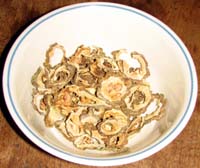 |
|
| Type: | Herbal tea |
|
|
|
| Other names: | Bitter melon, balsam pear, Momordica chinensis |
| Origin: | Brazil |
|
|
|
| Quick description: | Traditional medicinal. Makes a green, earthy broth also used in soup. |
|
|
|
Bitter melon tea, also called gohyah tea, is an herbal tea. It's made by soaking dried slices of bitter melon in hot water. This tea is sold as a traditional medicine and also used in cooking.
Images for kids
-
A Malaysian-style bitter gourd dish, cooked with sambal, onion, and red bird's-eye chili peppers
-
Filipino ampalaya con carne with egg, La Familia of Baliuag, Bulacan
-
Okinawan style gōyā chanpurū (ゴーヤーチャンプルー), a stir-fried dish
See also
 In Spanish: Melón amargo para niños
In Spanish: Melón amargo para niños


